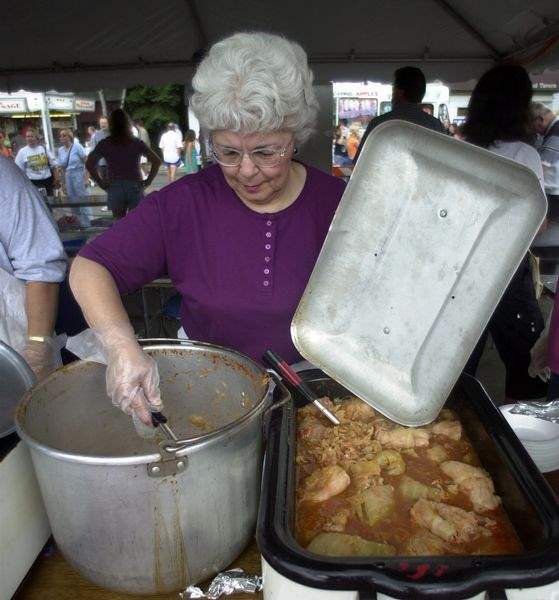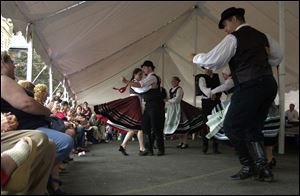
Birmingham glows: Neighborhood fest transcends ethnicity
8/20/2001
Pat Ziegler scoops out stuffed cabbages. Food, music, and neighborhood cohesiveness are the bywords of the annual East Toledo celebration.

The Kodaly ensemble of Toronto performs Hungarian dances under a tent during the Birmingham Ethnic Festival.
The cotton candy stands, pony rides, and giant blow-up beer bottles did not seem an incongruous backdrop to the traditional Hungarian dances being performed at yesterday's Birmingham Ethnic Festival in East Toledo.
The festival, which is held annually on Consaul Street since 1974, is a hybrid tradition - part paprikas and kolbaz, part funnel cakes and hot dogs. It got its start with the neighborhood's Hungarian population but has developed into a distinctly American celebration of greasy food and loud music.
Today, it remains a symbol of neighborhood cohesiveness, even as more ethnic groups move in and the original Hungarian population begins to fade. “That's why we call it an ethnic festival,” said Baba Ujvagi-Bertalan, whose husband, Imre BerTalan, is the former pastor of Calvin United Church of Christ, in the heart of the neighborhood. “Now we have Spanish, African-Americans - you name it.
“But we still have a sense of community. We are proud of all our cultures,” she said.

Pat Ziegler scoops out stuffed cabbages. Food, music, and neighborhood cohesiveness are the bywords of the annual East Toledo celebration.
Yesterday's event attracted an estimated 40,000 festival-goers, many of them with roots in the Birmingham neighborhood.
“A lot of people who grew up here like to come back,” said Marlene Farkas, who grew up in Birmingham and still lives there. “It's a collecting point for people.”
Jeff McClain, who lived there for 12 years, ran into an old friend who was working at a booth selling Hungarian food. A few years ago, he saw a former teacher from his grade-school days at St. Stephen's Church on Consaul Street.
Mr. McClain now lives on Lewis Avenue in West Toledo but said, “I'm really from this neighborhood.”
Toni Polsdorfer of Curtice has relatives in Birmingham and comes every year to see the Hungarian dancers. Her daughters, Haley, 6, and Alexa, 5, were transfixed by their traditional costumes - bell-shaped skirts and embroidered blouses on the women, black vests and hats on the men.
Interest in native dance is growing, even among third and fourth-generation Hungarians, said Ms. Ujvagi-Bertalan, who founded the Magyar Dancers of Toledo 19 years ago. The group is run through the Calvin United Church of Christ.
“You go through a period when you think it's going to die, then you get a whole slew of new people,” she said. “People realize how special their customs are. They remember their mother's embroidery, or their grandmother's paprikas.”
Dan Nowak of Maumee, who is admittedly Polish, came to the Hungarian festival for the music and the dance.
“I like the entertainment, though the beer doesn't hurt either,” he said. He also recommended the Hungarian - or “hunky” - turkey.
Vendor Karl Borko said the dish, which is not made of turkey at all, is one of his most popular. It consists of greased bread, tomatoes, peppers, and onions that are dribbled with bacon fat and topped with bits of bacon.
“It's an inside joke about the turkey, because the sandwich is so unhealthy,” he said.